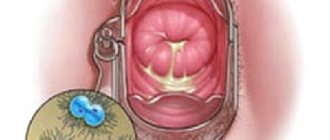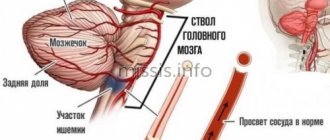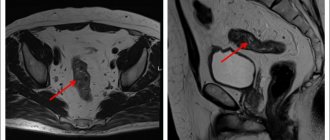Some time before giving birth, the expectant mother may be bothered by precursor contractions that appear from time to time and quickly pass. Let’s try to figure out how to distinguish false contractions from labor contractions and what their purpose is.
First of all, let's clarify the concept of contractions. These are rhythmic contractions of the uterus, are very intense and are an integral part of childbirth.
False contractions (precursor contractions) appear after the 20th week of pregnancy and are training before childbirth. At this time, there is no need to panic: the body is preparing for childbirth and “checking” all the systems on which its successful outcome depends.
What are contractions?
When labor begins, the cervix opens and effaces and the muscles of the uterus contract to help move the baby down through the birth canal. The contraction is similar to a spasm, which is first felt in the back and moves forward to the lower abdomen. Sometimes it can feel like a nagging pain in the back or pelvis, like during menstruation. During contractions, the abdomen hardens and then relaxes and remains softer between contractions.
When does your stomach drop?
3-4 weeks before the planned date of birth, the pregnant woman’s belly seems to slide down, this happens gradually and slowly. At the same time, the stomach changes somewhat in shape and decreases in size.
As the abdomen lowers, it becomes easier for a woman to breathe and eat as the diaphragm is released.
When symptoms of impending labor appear, a woman should rest more and save her strength for the main period of pregnancy - the birth of the baby.
Why is it useful to time contractions?
First, by measuring your contractions, you can determine whether labor has begun or whether these are just training contractions. Training contractions usually go away if you move around, and if they are not painful, not regular, and do not occur more and more often. Over time, real labor pains become more frequent, longer and more painful. Labor pains do not go away with movement or changing positions. Knowing how to time your contractions correctly will help you keep your doctor informed. Based on your dynamics, he may say that it’s time for you to go to the maternity hospital or, conversely, that you should stay at home for now.
Difference between signs in primiparous and multiparous
The anatomical structure of the uterus of a woman who has previously been in labor differs in a pregnant woman for the first time. The fact is that when passing through the birth canal, the fetal head exerts high pressure on the cervix, promoting its stretching. Due to this, it becomes more elastic, pliable and wider. Therefore, the first stage of labor in women who give birth again proceeds more quickly and less painfully. As a rule, it lasts from 3 to 7 hours, and for a primigravida it lasts from 6 to 12 hours.
Due to the fact that the body is better prepared for the process, signs of labor in multiparous women appear a little later, about a week before delivery. Also, their clinical picture may be more pronounced. In women pregnant for the first time, these manifestations are observed much earlier - approximately 15-20 days before the birth of the child.
For some mothers who give birth again, signs preceding the birth of a child may appear a day before it. Therefore, multiparous women need to carefully monitor their body from 34-35 weeks. The preparedness of the birth canal can affect the speed of the first period of delivery, so you should not delay your trip to the maternity hospital.
It is important to know that when contractions that are characterized by cyclicity appear, a woman giving birth again should go to the maternity hospital, since the first period of delivery may not always be accompanied by the development of pain or other manifestations.
If more than 8-10 years have passed between the birth of the last child and the new pregnancy, then the harbingers of labor in multiparous women may appear 12-14 days before delivery. This is due to the fact that over such a long period the woman’s body is completely restored, and the birth canal loses its elasticity.
Also, a woman should not be guided by how her previous pregnancy proceeded, since the influence of many factors (size of the fetus, height of the uterine fundus, the presence of concomitant diseases, etc.) can affect childbirth. Therefore, the appearance of signs can be observed at an earlier or later period, in comparison with the first birth.
If the first birth was carried out using a cesarean section, then the warning signs will appear in the same way as in women giving birth to a child for the first time. This is because the cervix did not stretch as the baby did not pass through the birth canal.
How to measure contractions during childbirth
How to measure contractions:
- write down when the first contraction began (the “time” item on the table below);
- how long the contraction lasts (“how long”);
- how much time passed from the start of one contraction to the start of the next (“frequency”);
- Keep records for at least an hour to determine if contractions are recurring or if the interval between them is getting shorter.
Example of contraction measurement records
You can ask your birth partner, midwife, or doula (if you're having one with you) to help you time your contractions. This way, you won't have to be distracted by it, and your partner may be pleased that he or she was useful to you.
Harbingers of childbirth
It is unlikely that labor will begin suddenly, without any preliminary symptoms. Most likely, you will have some new sensations on the eve of the day of birth and you will understand what is happening to you. Here are some common (but optional) signs of labor:
- Change in energy level.
If you suddenly feel very tired or, conversely, a sudden surge of energy a few days or weeks before giving birth, this is completely natural. Your nesting instinct may also awaken [https://www.pampers-gorodok.ru/pregnancy/pregnancy-symptoms/article/sindrom-gnezdovania], and you may want to do things around the house in anticipation of the arrival of a newborn in it. Don't overexert yourself - try to rest as much as possible and save your energy.
- The stomach drops.
The baby sinks lower into the pelvis weeks, days or hours before birth. As a result, your tummy also drops.
- Removal of the mucus plug.
You may notice a thick pinkish discharge or discharge streaked with blood. Most likely, this is a mucus plug that protected the cervix during pregnancy. Often the plug comes off a few days before the onset of contractions, but some expectant mothers do not even notice this.
What is the difference between labor contractions and training contractions?
Labor contractions, as a result of which the child is born, occur at repeated intervals and become more frequent and intense. If your contractions are irregular and not getting stronger each time, you may be experiencing Braxton Hicks contractions, also known as training contractions, or false contractions. Braxton Hicks contractions do not mean the start of labor - your body is just preparing for the impending birth. Signs of labor include rupture of the amniotic sac (they also say “your water has broken”) and the release of the mucous plug (clear or pinkish discharge from the vagina).
Reasons for the onset of labor in different periods
From the moment of conception to the onset of birth, pregnancy normally lasts 38 weeks, or 266 days. However, it is often very difficult to determine the date of fertilization of an egg by a sperm. Therefore, in obstetric practice, it is customary to consider the day of conception to be the date of the beginning of the last menstruation. Based on this, the norm is considered to be the onset of labor between 37 and 42 weeks. The birth of a baby during this period is usually called a full-time birth (urgent). Preterm birth also occurs, occurring between 22 and 37 weeks. And also late births, in which the baby is born after 43 weeks.
Currently, scientists cannot say for sure what causes childbirth. Theories about what factors in labor have appeared throughout the development of medicine.
One of the first to suggest what provokes labor was Hippocrates. He believed that the fetus rests its feet on the fundus of the uterus and thus independently emerges into the light due to a feeling of hunger.
Modern science believes that childbirth occurs at the moment when the pregnant woman has formed a generic dominant, which is a specific state of the nervous system. It helps to bring to the fore the reflexes that every woman has, as well as to rebuild the hormonal background of the woman in labor. This is how the body prepares for the birth process.
To make childbirth less painful, a woman’s body undergoes significant changes both in the activity of the nervous system and at the hormonal level.
Premature births are common. They are divided into 3 types:
- Very early (22–27th week) – fetal weight from 500 to 1000 g.
- Early premature birth (28–33rd week) – newborn weight from 1000 to 2000 g.
- Premature birth at 34–37 weeks - baby weight about 2500 g.
There is also a distinction between the threat of premature birth, as well as the beginning and the beginning of labor ahead of schedule. When there is a threat and the birth process begins, doctors do everything possible to prevent the baby from being born prematurely. If labor does begin, the condition of the woman and baby is monitored especially carefully.
The reasons that a child is born prematurely may be:
- inflammatory and infectious diseases of the mother;
- pathologies of the reproductive organs (uterus, cervix);
- hormonal disorders;
- multiple pregnancy;
- polyhydramnios;
- endocrine diseases, such as diabetes;
- great physical activity;
- stress;
- bad habits (alcohol, smoking, drugs);
- malnutrition;
- past abortions;
- diseases of the nervous system, kidneys, heart;
- gestosis (pathological condition of a pregnant woman in late stages, which is characterized by disruption of the kidneys, blood vessels and brain activity of a woman);
- Rh conflict between mother and fetus;
- transverse position of the fetus;
- placenta previa.
Before medicine learned to care for babies weighing more than 500 g, childbirth before 28 weeks was considered a miscarriage.
Modern medicine has learned to care for very tiny babies born prematurely.
The following factors may be the causes of late birth or post-term pregnancy:
- neuroendocrine diseases: diabetes mellitus, hypothalamic syndrome (damage to the hypothalamus) and others;
- lack of synchronous readiness of mother and fetus for the due date, which is characterized by a complex of problems on both the part of the woman and the child: the dominant of labor is not formed in time, the unpreparedness of the cervix, malformations of the central nervous system in the fetus and others;
- hormonal disorders;
- atrophy or degeneration of the amniotic bladder or placenta;
- delayed or partial maturation of the placenta;
- impaired functioning of the mother's central nervous system.
Is it true that repeated births occur earlier than the first?
According to popular belief, a multiparous woman gives birth to her second child a little earlier than her first. Many women on forums actually confirm that this is what happened to them. However, doctors, on the contrary, talk about the tendency of multiparous women to “overstay” their pregnancy. There are no official statistics regarding the answer to this question.
At the same time, we should not forget about factors such as the mother’s health, living conditions and others that may have changed since the first birth. However, if the first birth was premature, then the likelihood that the second will occur prematurely is very high. Therefore, the mother should regularly visit the doctor and be under constant supervision.
The due date of the second and subsequent pregnancies depends on many factors
When to go to the maternity hospital
When visiting your doctor in the third trimester, find out his recommendations for when you need to go to the hospital and stick to them. At the same time, ask what number to call if you go into labor while your doctor is not open. In many cases, the recommendation is to call your doctor when you notice signs of labor, such as your water breaking, mucus plug, or contractions starting. Be prepared to tell your doctor how often contractions occur and how long each contraction lasts, as well as other signs, if any. If you notice bleeding, call your doctor immediately. Based on the information you tell him, the doctor will tell you whether you should go to the maternity hospital or whether it’s better to stay at home for now, in a calmer and more comfortable environment for you, suitable for the first stage of labor.
When will I go into labor?
The expected date of birth (EDD) is the day when the pregnancy is exactly 40 weeks. However, you should not rely on the fact that the baby will be born on this day. Firstly, the due date may be inaccurate, 75% of it is just a rough estimate, and the “error” could be as much as two weeks off, even if the date was corrected after an ultrasound. Most women go into labor between 38 and 42 weeks. Take your time, listen to your body and keep your birth plan and hospital bag handy. Keep in mind that experts do not recommend using any traditional medicine to induce labor. If you are concerned that labor is not starting, discuss this with your doctor.
What to do at home during the first stage of labor
From the time you start having contractions until the time you need to go to the hospital, your doctor may recommend that you stay home for now. Here's what you can do during this time:
- do breathing and relaxation exercises;
- go for a walk;
- take a nap;
- take a shower or bath;
- listen to relaxing music or watch a movie;
- finish packing for the maternity hospital
Specialists
Makatsaria Alexander Davidovich
Obstetrician-gynecologist, famous scientist, founder of clinical hemostasiology.
It will help you plan and maintain your pregnancy if you have had cases of fetal loss, thrombosis, obstetric complications or blood coagulation disorders. You can also contact your doctor for a transcript of hemostasis tests.
Egorova Elena Borisovna
Obstetrician-gynecologist of the highest qualification category.
Specializes in peritoneal factor of infertility in women and management of problematic pregnancies.
It will provide effective help if, before conception, you were diagnosed with adhesions, endometriosis, erosion or other pathologies of the cervix.
Akinshina Svetlana Vladimirovna
Obstetrician-gynecologist, hemostasiologist with an academic degree.
Pregnancy management S.V. Akinshina will help avoid severe complications: gestosis, placental insufficiency, fetal loss syndrome.
The doctor's expertise includes hemostasis disorders and immunological infertility.
Bitsadze Victoria Omarovna
Gynecologist-hemostasiologist, professor, doctor of medical sciences.
The doctor's profile is management of high-risk pregnancies, including in women with genetic thrombophilia and a tendency to spontaneous bleeding. Develops effective treatment regimens for infertility associated with autoimmune pathologies and hemostasis disorders.
Signs of the onset of labor
Although each pregnancy proceeds differently, there are still characteristic early signs of labor. Some of them may be very subtle and you may not even notice them. The most common first sign of labor is contractions. Shortly before birth, the cervix, the lower part of the uterus, softens, thins, and shortens. You may feel slight discomfort, perhaps even a few mild, irregular contractions. The cervix will also begin to gradually dilate. The opening will accelerate over time. You may experience more regular contractions—every 5 to 15 minutes—lasting 60 to 90 seconds. Try not to be nervous and monitor the duration, frequency and regularity of contractions. The latent phase of the first stage of labor is unpredictable in its duration. It may take hours or days before you enter the active phase of the first stage of labor, especially if this is your first labor. The latent phase usually lasts less in subsequent births. Until your contractions become more regular and intense, or until your water breaks, try to simply relax. But call your doctor right away if you notice bleeding (bright red), if your water breaks (especially if the fluid is green or brown and smells bad), if your child is less active or if you have a headache, blurred vision, or increased blood pressure. arterial pressure. Also call your doctor if you think you're going into preterm labor.










